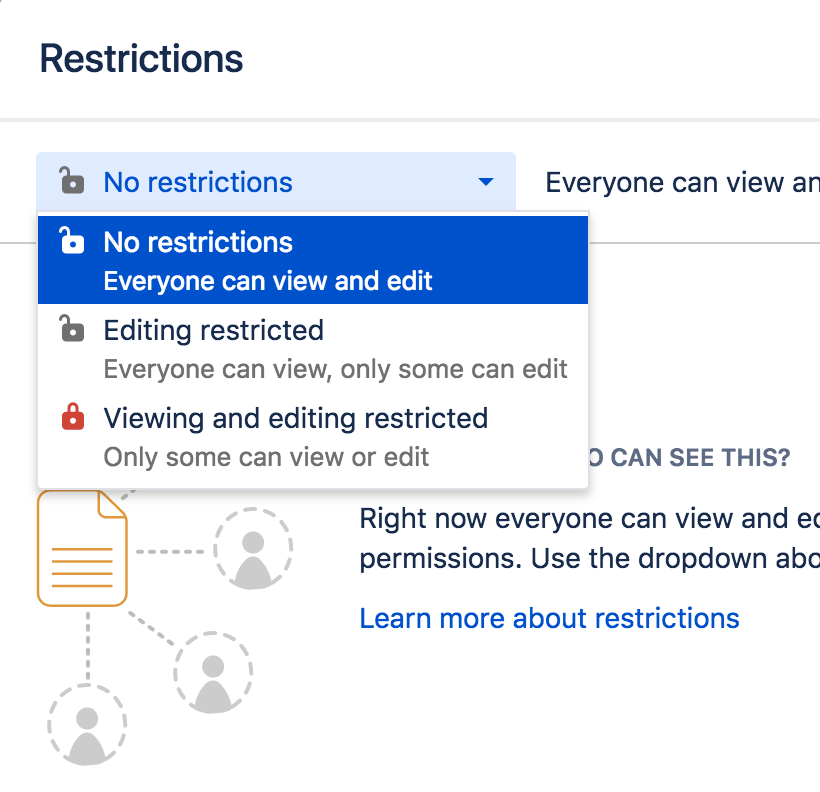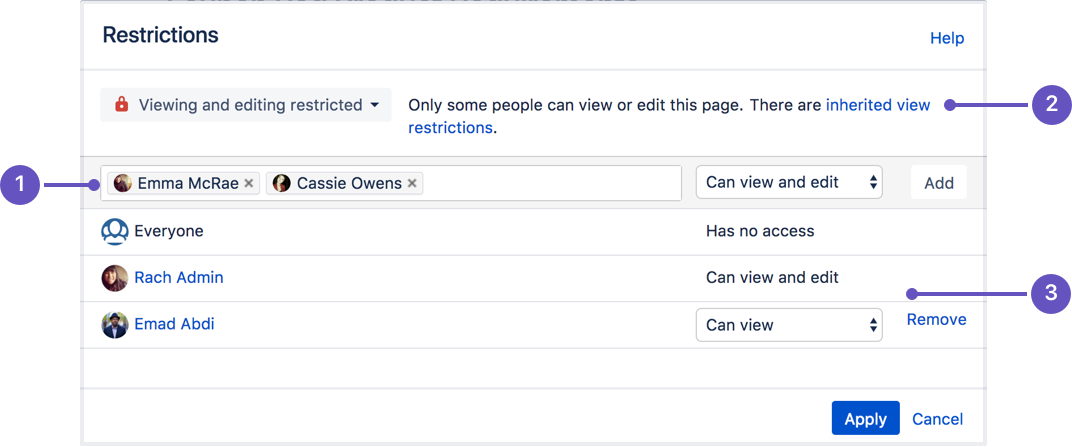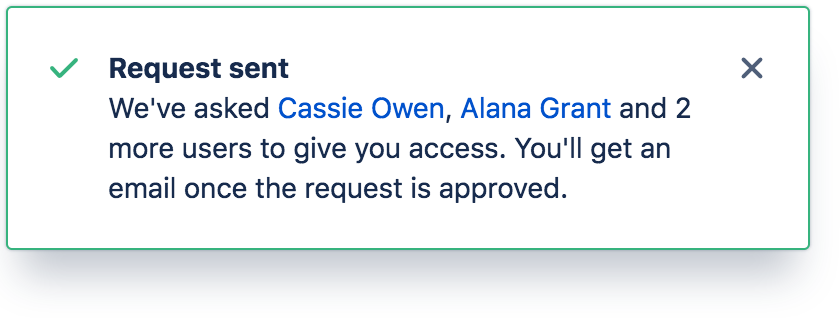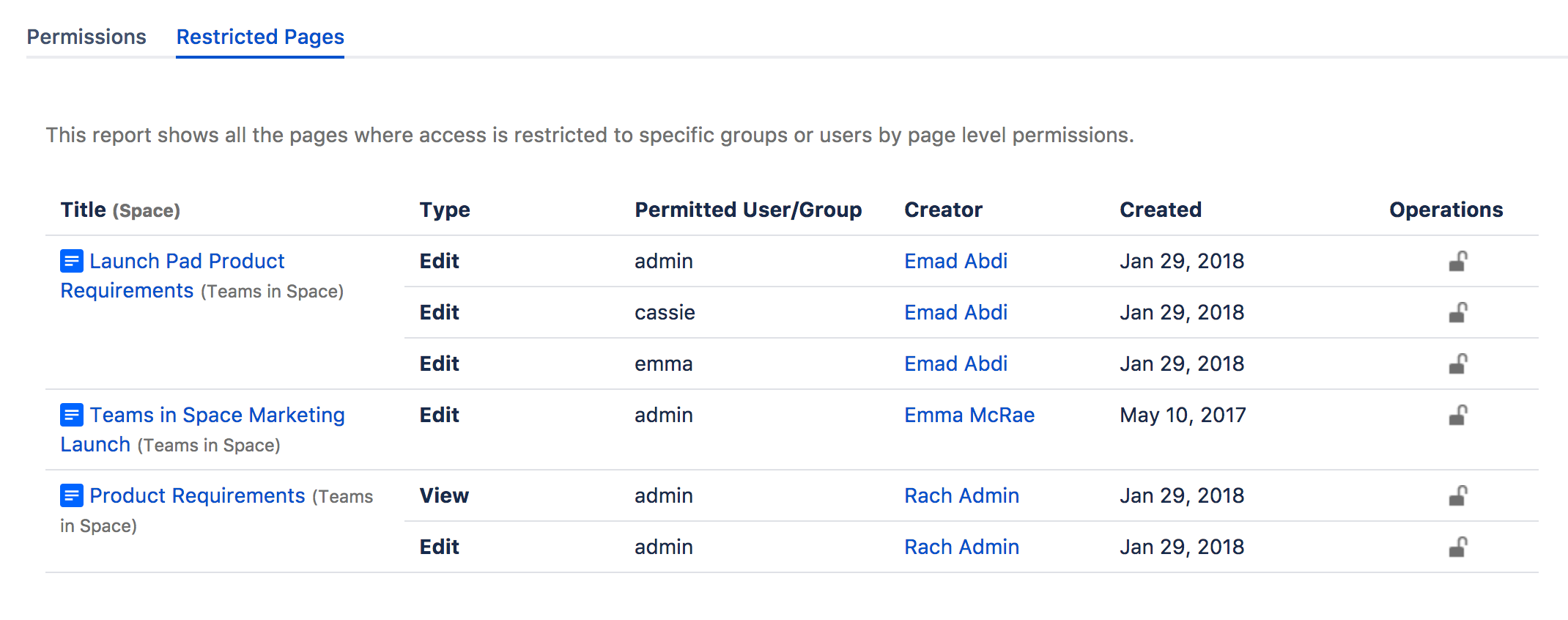Page Restrictions
Page restrictions allow you to control who can view and/or edit individual pages in a space. So, if you're working on a page that shouldn't be viewed by just anybody, it's easy to lock it down to the people who need to know. You can add restrictions for individuals or for Confluence groups.
To add or remove page restrictions, you'll need to have permissions to edit the page and 'Restrict' or 'Admin' permission in the space.
Restrict a page or blog post
On this page:
To restrict who can view or edit a page or blog post:
- Choose the Restrictions icon at the top of the page.
- Choose whether you just want to limit only who can Edit, or who can View and / or Edit.
- Enter users or groups then click Add to add them to the list.
If you chose Viewing and Editing restricted you can further specify for each person or group whether they can edit or just view the page. - Apply the restrictions.
You can add as many users and/or groups as you need. You can apply page restrictions to published and unpublished (draft) pages.
In this example, some users and groups can view only, others can also edit, plus there are inherited restrictions that might impact who can view the page.
- Speed it up: apply the same restriction to multiple people and groups.
- Watch out: restrictions on other pages can affect this one.
- Be specific: choose exactly what each group or person can do.
Who is 'everyone'?
When we say "everyone can view this page" everyone means all the people who can view the page by default. There are two things that can affect who can view a page - the space permissions, and view restrictions on any parent pages that are being inherited.
Restrictions don't override a person's space permission. For example, if you say a person 'can view' in the restrictions dialog and they don't have 'view' permissions for the space, they won't be able to see the page.
How do inherited restrictions work?
View restrictions are inherited, which means a restriction applied to one page will cascade down to any child pages. Edit restrictions are not inherited, which means pages need to be restricted individually.
The restrictions dialog will tell you when there are inherited restrictions that might affect who can view your page.
Here's the basics:
- If you restrict viewing to a person or group, only they will be able to see that page and all its child pages (unless there are further restrictions on the child pages).
- If you restrict editing to a person or group, they'll be able to see and edit that page, plus see its child pages.
- Parent pages (higher up in the page hierarchy) can have their own view restrictions that may prevent people from viewing your page.
If the person you've listed as a viewer or editor can't see the page, check to make sure:
- they have View space permission for that space, or
- there's no view restriction on a page higher up the page hierarchy that prevents them seeing any children of that page.
View current page restrictions
The restrictions icon at the top of the page gives you a clue that the page has restrictions:
| Viewing this page is not restricted. Everyone can see this page (but editing may be restricted). | |
| The page is restricted. Click the icon to see the list of who can view and edit this page. | |
| The page is inheriting restrictions from another page. Click the icon then choose Inherited Restrictions to see a list of pages this page is inheriting restrictions from. |
Remove restrictions from a page
Removing restrictions is easy. Choose No restrictions to remove all restrictions, or click Remove next to each person or group in the list if you want to change who can view or edit the page.
Copy a restricted page
When you copy a single page, we don't automatically copy the restrictions. If the page contains information that should be private, remember to reapply restrictions in the editor before you publish, to avoid notifying people who are watching the space.
When you copy a page and all its child pages, you have the option to copy all restrictions, or skip copying restrictions on all pages. See Copy a Page for more information.
Get access to a restricted page
If you navigate to a page that you're not able to view or edit because it has page restrictions applied (for example from a link, an invite, or page URL) you may be able to request access to the page.
If the request access message above doesn't appear, you're not able to request access for that particular page. This usually is because the page has inherited view restrictions from a parent page, you don't have adequate space permissions, or there is no mail server set up.
Request access
To request access to a restricted page:
- On the restricted page choose Request access.
- Confluence will send an email to up to 5 people most likely to be able to grant you access.
- Wait for an email confirming that access has been granted.
Grant access
To grant access to a restricted page:
- In the request access email, choose Grant access.
You'll be taken to the restricted page, and a dialog will appear with the access request. - Choose Grant access.
(We'll let you know if someone else got there before you, and has already granted access)
The user will receive an email confirming that access has been granted.
This process is the same as navigating to
Who can grant access?
When a user requests access to a restricted page, Confluence will send an email to up to 5 people who are most likely to be able to grant access, in the following order:
- people who have contributed to the page in the past, can see the page and have 'Restrict' or 'Admin' space permission (sorted by last edit date)
- space administrators who can see the page (sorted alphabetically).
This means that the request should be actioned quickly, as it prioritizes the people who have been interacting with the page most recently. There's no follow up email if none of the 5 people respond, the user will need to contact a space administrator directly to ask for access.
Disable the ability to request access
If you don't want people to be able to request access to restricted pages, for example if you're using Confluence for public documentation, you can disable the Confluence Request Access Plugin. See Managing System and Marketplace Apps.
View all restricted pages in a space
You need space admin permissions to view the list of restricted pages in a space.
To view restricted pages:
Go to the space and choose Space tools > Permissions from the bottom of the sidebar
- Choose Restricted Pages.
Screenshot: Restricted pages in a space
Notes
- You can't exclude yourself
When you apply a restriction, Confluence will automatically add you to the list. You can't remove yourself from this list. Space Admin and System Administrator access to restricted pages
Users with 'Admin' permissions in a space, or users with the System Administrator global permission can remove restrictions from pages, even if the page restriction prevents them from viewing the page. Go to Space Administration > Restricted Pages.





